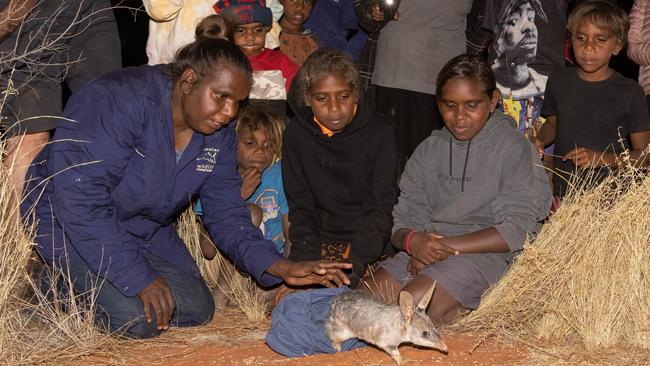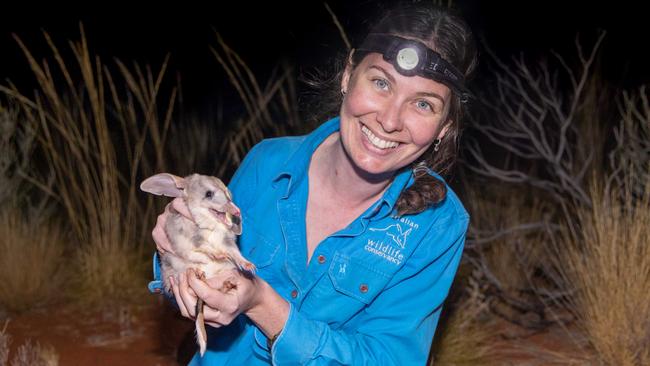Vulnerable bilbies and bettongs return to Red Centre sanctuary
A patter of tiny feet will soon be felt over the arid plains of Central Australia as bilbies and burrowing bettongs return to Newhaven Wildlife Sanctuary.

A patter of tiny feet will soon be heard on the arid plains of Central Australia where they have not been for at least half a century.
This week, the Australian Wildlife Conservancy is reintroducing 32 greater bilbies and 65 burrowing bettongs to the Newhaven Wildlife Sanctuary west of Alice Springs.
Newhaven is a roughly 10,000ha fenced area – one of the largest in Australia – of resplendent outback painstakingly cleansed of feral predators.
It and other sanctuaries like it are among the few places where some of the nation’s most vulnerable species can survive outside of close captivity.
Bilbies and bettongs disappeared from the Southern Tanami region in the middle of the 20th century, pushed out by cats, foxes, different burning regimes and new agricultural practices.
Warlpiri ranger Alice Nampijinpa Henwood travelled to Newhaven with local schoolkids to be on site when the bilbies (ninu) arrived. The bettongs are expected soon.
“When the kids saw them, they got real happy, and I got happy too,” she said. “My mum and my dad (taught) me how to find bilbies, (how to) dig them up. When I was a teenager, I walked a long way, and I found ninu.”
AWC wildlife ecologist Kirsten Skinner describes the animals as “ecosystem engineers”.
“They are species that will be out every night digging little holes across the landscape as they forage for insects, tubers, roots, seeds and grasses,” she said.
“This process of them digging up the landscape really helps in nutrient cycling, promoting germination of native plants. Also their burrows are used by other species as thermal refuges in this hot, arid environment.”
AWC has so far reintroduced marla, red-tailed phascogales and brush-tailed bettongs to Newhaven and is aiming to bring back at least 10 locally extinct species.
Ms Skinner says the reintroduced species are thriving after a period of heavy rainfall.
“(The rain) created an explosion of vegetation across Newhaven, and we’ve seen the animals respond to that,” she said.

“We’ve done surveys … the marla have increased in body condition, increased in weight and … are breeding a lot more than when they were first reintroduced.”
The bilbies were brought in from Taronga Western Plains Zoo in Dubbo, NSW, where a breeding program is under way to support rewilding projects such as the one at Newhaven.
The burrowing bettongs will come from the Matuwa Kurrara Kurrara Indigenous Protected Area in Western Australia, the Scotia Wildlife Sanctuary in NSW and the Yookamurra Wildlife Sanctuary in South Australia.
Taronga Conservation Society Australia boss Cam Kerr is thrilled to see the animals go back to the wild. “This is Taronga’s second release of this incredible Australian marsupial back to the wild, and we are so proud of the collaborative conservation effort to get greater bilbies back on to the country where they were once found,” he said.
Wiluna Rangers manager Dorian Moro said sourcing bettongs from Matuwa was a proud moment for his colleagues and local traditional owners.
“It’s important to be here where our grandparents and their grandparents lived. It is part of our past, present, and future,” ranger Ruth Wongawol said.
Ranger Leonie Anderson felt good about sharing Matuwa animals with other traditional owner groups. “We can show other traditional owner rangers how good it is to have these animals live on their country too,” she said.
AWC estimates it protects about 1000 greater bilbies, 10 per cent of the surviving population. It expects to protect five times that number within a decade.
Other threatened and locally extinct species such as the golden bandicoot, numbat, brushtail possum, central rock rat, western quoll and shark bay mouse are planned to be restored to Central Australia in coming years.






To join the conversation, please log in. Don't have an account? Register
Join the conversation, you are commenting as Logout